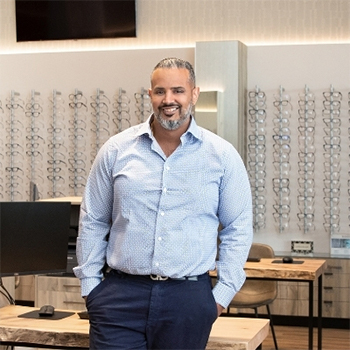August often feels like a month of transition. Families are wrapping up summer activities, preparing for the start of school, and setting routines for the year ahead. In the middle of all the busy preparations, it can be easy to focus on school supplies, new clothes, and lunch boxes while overlooking one of the most important parts of back-to-school readiness: a child’s vision.
Healthy eyesight is not just about seeing clearly. It is directly linked to a child’s ability to learn, play safely, and develop confidence. August is Children’s Eye Health and Safety Month, which serves as a timely reminder that regular eye care is just as essential as an annual physical. This is the perfect time to give your child the best start possible for the school year by making their eye health a top priority.
Why is children’s eye health so important?
Children rely heavily on their vision for learning and everyday activities. In fact, research suggests that a significant portion of learning in early childhood is visual. From reading a book to copying notes from the board to participating in sports or arts, healthy eyes are the foundation for many skills.
When a child’s eyesight is not at its best, the effects can be wide-ranging. Academically, they may struggle to keep up with reading assignments or have difficulty understanding lessons because they cannot see clearly. Socially, they may shy away from group activities, sports, or games because they find it hard to follow what is going on. Even their safety can be affected, especially if poor vision causes them to misjudge distances or overlook obstacles.
Good eye health in childhood also has a long-term impact. Many vision problems can be corrected more easily when they are caught early. For example, a condition like amblyopia, often called lazy eye, responds best to treatment during the early developmental years. By ensuring your child’s eyes are checked regularly, you are investing in their present comfort and their future well-being.
How can vision problems affect school performance?
The classroom is a visually demanding environment. Children need to be able to read from a variety of distances, whether they are looking at a whiteboard, reading a book, or working on a tablet. When vision is blurry or strained, these everyday tasks become much harder.
Imagine a child sitting at the back of the classroom who cannot see the board clearly. They may start guessing at the letters and numbers or simply tune out of the lesson. Over time, this can lead to gaps in learning and frustration with schoolwork. Some children might avoid reading altogether because it gives them headaches or makes them tired quickly.
Vision problems can also be mistaken for learning or behavioural challenges. A child who appears distracted or restless might simply be having trouble seeing. Without regular eye exams, these issues can go undetected for months or even years, and the child’s confidence can take a hit.
Teachers are often among the first to notice signs of vision trouble, but parents play a crucial role too. Scheduling an annual comprehensive eye exam, even when your child seems to see well, can prevent vision-related struggles before they start interfering with learning.
How can parents keep their children’s eyes safe?
Eye safety is as important as eye health. Injuries can happen in the blink of an eye, but many are preventable with a few simple habits. Parents can reduce the risk of eye injury and strain by making these practices part of their child’s routine.
- Encourage the use of protective eyewear during sports, especially those involving fast-moving balls or objects such as hockey, baseball, or racquetball. Sports goggles are designed to absorb impact and protect the eyes from injury.
- Provide sunglasses that block 100 percent of ultraviolet rays whenever your child spends time outdoors. This helps prevent long-term damage to the eyes from sun exposure.
- Teach safe habits during play, such as not pointing sharp objects near the face and avoiding the use of dangerous toys or projectiles.
- Limit continuous screen time by encouraging regular breaks. Prolonged use of phones, tablets, or computers can cause digital eye strain, leading to dryness, headaches, and blurred vision.
- Keep household chemicals and cleaning supplies out of reach to avoid accidental splashes that could harm the eyes.
What signs should parents watch for?
It is important to recognize the early signs of vision problems so they can be addressed quickly. The following are some common indicators that your child may need an eye exam:
- Squinting or tilting the head to see more clearly
- Holding books, devices, or objects unusually close to the face
- Frequent headaches or complaints about tired eyes
- Covering one eye while reading or watching television
- Trouble focusing on tasks or losing their place while reading
- Avoiding activities that require good vision, such as puzzles or ball games
If you notice one or more of these signs, schedule an appointment with an optometrist. Even if your child passed a school vision screening, a comprehensive eye exam is the best way to detect hidden problems.
How often should children have their eyes checked?
Eye care for children should begin early and continue regularly as they grow. These guidelines can help you stay on track:
- The first comprehensive eye exam should happen between six and twelve months of age. This early check can detect serious conditions that might otherwise go unnoticed.
- Another exam should be done at least once between the ages of three and five to make sure the eyes are developing normally.
- Once a child starts school, yearly eye exams are recommended. Children’s vision can change quickly, and annual exams help ensure they always have the correct prescription and healthy eyes.
Following this schedule gives your child the best chance to maintain clear, comfortable vision throughout their school years. August is a month for fresh starts. Before the school year begins, give your child the gift of clear vision and healthy eyes. A comprehensive eye exam is a simple step that can make a lasting difference in their learning, confidence, and safety. Book your child’s appointment at Vision Care Centres today and help them start the school year ready to see and succeed.


